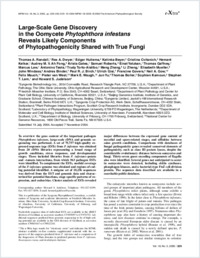Large-scale gene discovery in the oomycete Phytophthora infestans reveals likely components of phytopathogenicity shared with true fungi
- Dwyer, Rex A. Syngenta Biotechnology Inc., Research Triangle Park, North Carolina, U.S.A.
- Huitema, Edgar Department of Plant Pathology, The Ohio State University, Ohio Agricultural Research and Development Center, Wooster, U.S.A.
- Beyer, Katinka Friedrich Miescher Institute, Basel, Switzerland
- Cvitanich, Cristina Department of Plant Pathology and Center for Plant Cell Biology, University of California, Riverside, U.S.A.
- Kelkar, Hemant Syngenta Biotechnology Inc., Research Triangle Park, North Carolina, U.S.A.
- Ah Fong, Audrey M. V. Department of Plant Pathology and Center for Plant Cell Biology, University of California, Riverside, U.S.A.
- Gates, Krista Syngenta Biotechnology Inc., Research Triangle Park, North Carolina, U.S.A.
- Roberts, Samuel Department of Plant Pathology and Center for Plant Cell Biology, University of California, Riverside, U.S.A.
- Yatzkan, Einat Syngenta Biotechnology Inc., Research Triangle Park, North Carolina, U.S.A.
- Gaffney, Thomas Syngenta Biotechnology Inc., Research Triangle Park, North Carolina, U.S.A.
- Law, Marcus Syngenta Biotechnology Inc., Research Triangle Park, North Carolina, U.S.A.
- Testa, Antonino Department of Plant Pathology, The Ohio State University, Ohio Agricultural Research and Development Center, Wooster, U.S.A.
- Torto-Alalibo, Trudy Department of Plant Pathology, The Ohio State University, Ohio Agricultural Research and Development Center, Wooster, U.S.A.
- Zhang, Meng Beijing Genomics Institute, Institute of Genetics, and Graduate School, Chinese Academy of Sciences, Beijing, China
- Zheng, Li Syngenta Biotechnology Inc., Research Triangle Park, North Carolina, U.S.A.
- Mueller, Elisabeth Syngenta Limited, Jealott's Hill International Research Station, Bracknell, Berks, U.K.
- Windass, John Syngenta Limited, Jealott's Hill International Research Station, Bracknell, Berks, U.K.
- Binder, Andres Syngenta Crop Protection AG, Werk Stein, Schaffhauserstrasse, Stein, Switzerland
- Birch, Paul R. J. Plant Pathogen Interactions Program, Scottish Crop Research Institute, Invergowrie, Dundee, Scotland
- Gisi, Ulrich Syngenta Crop Protection AG, Werk Stein, Schaffhauserstrasse, Stein, Switzerland
- Govers, Francine Laboratory of Phytopathology, Wageningen University, The Netherlands
- Gow, Neil A. Department of Molecular and Cell Biology, Institute of Medical Sciences, University of Aberdeen, Foresterhill, Aberdeen, Scotland, U.K.
- Mauch, Felix Department of Biology, University of Fribourg, Switzerland
- West, Pieter van Department of Molecular and Cell Biology, Institute of Medical Sciences, University of Aberdeen, Foresterhill, Aberdeen, Scotland, U.K.
- Waugh, Mark E. National Center for Genome Resources, Old Pecos Trail, Santa Fe, U.S.A
- Yu, Jun Beijing Genomics Institute, Institute of Genetics, and Graduate School, Chinese Academy of Sciences, Beijing, China
- Boller, Thomas Friedrich Miescher Institute, Basel, Switzerland
- Kamoun, Sophien Department of Plant Pathology, The Ohio State University, Ohio Agricultural Research and Development Center, Wooster, U.S.A.
- Lam, Stephen T. Syngenta Biotechnology Inc., Research Triangle Park, North Carolina, U.S.A.
- Judelson, Howard S. Department of Plant Pathology and Center for Plant Cell Biology, University of California, Riverside, U.S.A.
-
2005
Published in:
- Molecular Plant-Microbe Interactions. - 2005, vol. 18(3), p. 229
English
To overview the gene content of the important pathogen Phytophthora infestans, large-scale cDNA and genomic sequencing was performed. A set of 75,757 high-quality expressed sequence tags (ESTs) from P. infestans was obtained from 20 cDNA libraries representing a broad range of growth conditions, stress responses, and developmental stages. These included libraries from P. infestans–potato and –tomato interactions, from which 963 pathogen ESTs were identified. To complement the ESTs, onefold coverage of the P. infestans genome was obtained and regions of coding potential identified. A unigene set of 18,256 sequences was derived from the EST and genomic data and characterized for potential functions, stage-specific patterns of expression, and codon bias. Cluster analysis of ESTs revealed major differences between the expressed gene content of mycelial and spore-related stages, and affinities between some growth conditions. Comparisons with databases of fungal pathogenicity genes revealed conserved elements of pathogenicity, such as class III pectate lyases, despite the considerable evolutionary distance between oomycetes and fungi. Thirty-seven genes encoding components of flagella also were identified. Several genes not anticipated to occur in oomycetes were detected, including chitin synthases, phosphagen kinases, and a bacterial-type FtsZ cell-division protein. The sequence data described are available in a searchable public database.
- Faculty
- Faculté des sciences et de médecine
- Department
- Département de Biologie
- Language
-
- English
- Classification
- Biological sciences
- License
- License undefined
- Identifiers
-
- RERO DOC 5058
- DOI 10.1094/MPMI-18-0229
- Persistent URL
- https://folia.unifr.ch/unifr/documents/299868
Statistics
Document views: 148
File downloads:
- 1_mauch_lsg.pdf: 257
